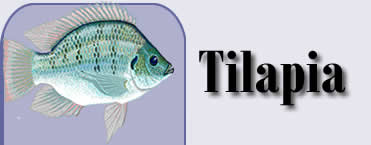Tilapia Recipes
Welcome to our collection of our own favourite tilapia recipes!
Tilapia is a common name used for nearly a hundred different cichlid species belonging to the chicklid tribe Tilapiine in the subfamily Pseudocrenilabrinae. Tilapia is most commonly found in freshwater but populations do occur in brackish environments as well. Tilapia lives in lakes, estuaries and ponds as well as in streams and rivers.
The name Tilapia is derived from the Tswana word for fish: thiape. Tswana is a Bantu language belonging to the Niger-Congo language family. Some species of tilapia is referred to as "St. Peter's fish" since there is a passage in the Christian Bible where the apostle Peter catches a fish that carries a shekel coin in its mouth. According to legend, the dark spots present on the sides of these tilapia species are the finger marks of Saint Peter.
Tilapia has been fished by man for thousands of years and is for instance known to have been of significant importance for artisan fishermen in African and the Levant region. Many popular tilapia recipes are several hundred years of age or more and have been passed down through the generations. With the advent of the Internet, we can easily share and try local tilapia recipes from all over the planet and also add our own little twist to them, using ingredients available in our very own corner of the world.
Fish as food
Fish is high in protein and provide us with several important vitamins and beneficial fatty acids. If you wish to cut down on fat to become more healthy, fish-fat is certainly not the thing that you should remove from you diet because the fat found in fish tend to be “good fat”. An increasing number of studies have showed that eating fish on a regular basis can reduce the risk of heart disease since it contains beneficial omega-3 fatty acids.
According to nutritiondata.com, 100 grams of raw tilapia contains no more than 96 kcal and out of that, 80 kcal are in the form of protein. Tilapia is also en excellent source of vitamin B3 (niacin), vitamin B12 and selenium. Read more about the nutritional value of tilapia.
If you have never prepared fish before, tilapia is a good beginner fish because it is readily available in most parts of the world and tends to be fairly inexpensive. It is also easy to cook and can be prepared in a long row of different ways to accommodate your particular taste buds. You can find a broad selection of tilapia recipes here. Today when more and more people try to limit their intake of endangered species such as cod, the prolific tilapia has become an interesting alternative. In many traditional fish recipes, tilapia can be used instead of other fishes that might be endangered or hard to come by nowadays. It should however be stressed that tilapia comes with its own sets of environmental issues that must be overcome, e.g. the problem that it can cause as an invasive species.
Tilapia in aquacultures
Tilapia has today become the third most important fish in aquaculture, particularly the species belonging to the genera Tilapia, Sarotherodon and Oreochromis. These fishes grow rapidly, become really large and are not very difficult to farm on a commercial scale since their fry do not pass through a planktonic phase. They are omnivores with a preference for soft aquatic vegetation and detritus, unlike salmon who must be fed protein rich food consisting of fish or some other type of meat.
A majority of the aquacultures are found in tropical and sub-tropical parts of the world since tilapia is a tropical fish that needs warm water, but it is possible to cultivate tilapia in temperate climates as well by making use of waste heat from power stations or factories. Another example of how tilapia farming can be cleverly combined with other ventures is how South-East Asian rice farmers sometimes place tilapia in their flooded rice fields. A small tilapia fish that is placed in the filed when the rice is planted will have reached edible size when its time to harvest the rice.
Problems associated with tilapia
Tilapia can easily become a problematic invasive species when introduced to new environments. Tilapia can escape from aquacultures, but they can also be deliberately introduced as food fish without regard to the problems they might cause for the local ecosystem. Tilapia has also been introduced in order to combat problems with plants such as duckweed and filamentous algae. In countries such as Kenya, tilapia is used to combat the mosquito responsible for the spread of malaria since tilapias are fond of eating mosquito larvae.
Tilapia recipes:
